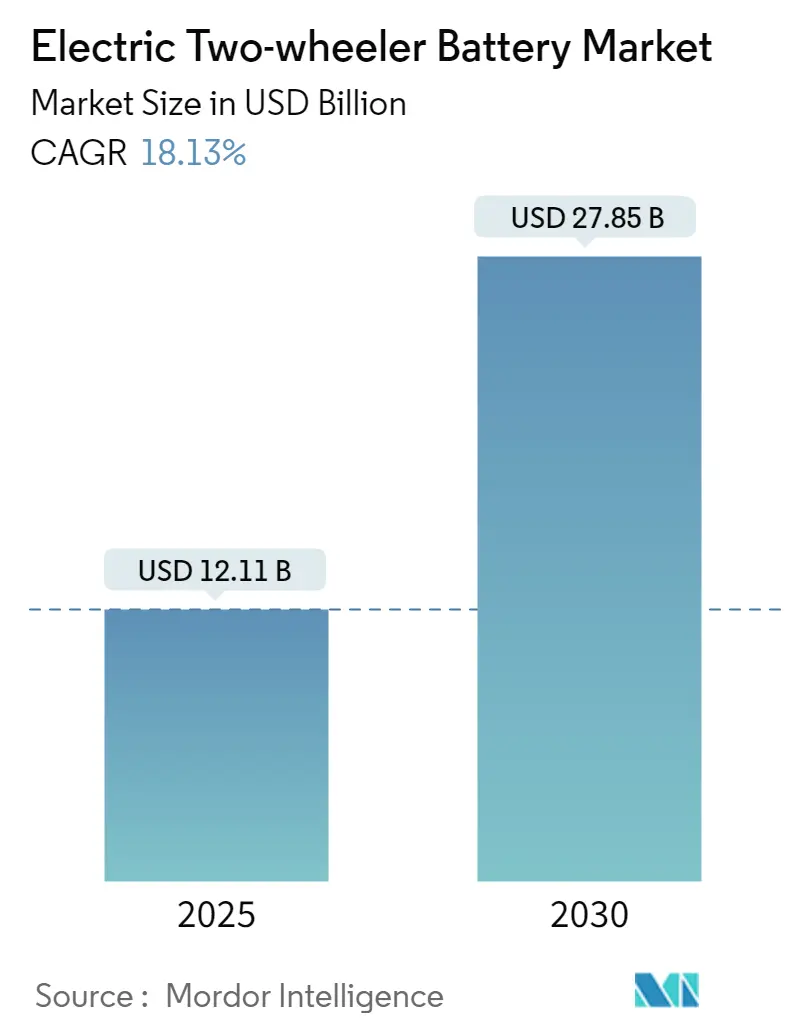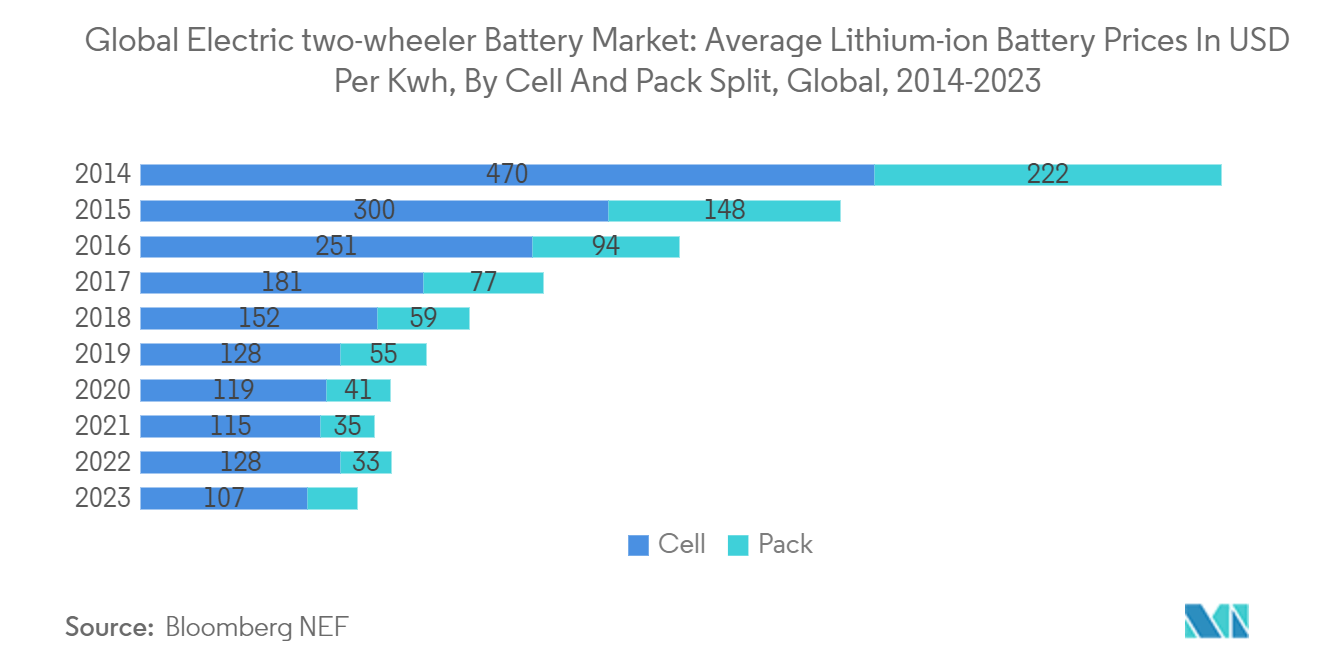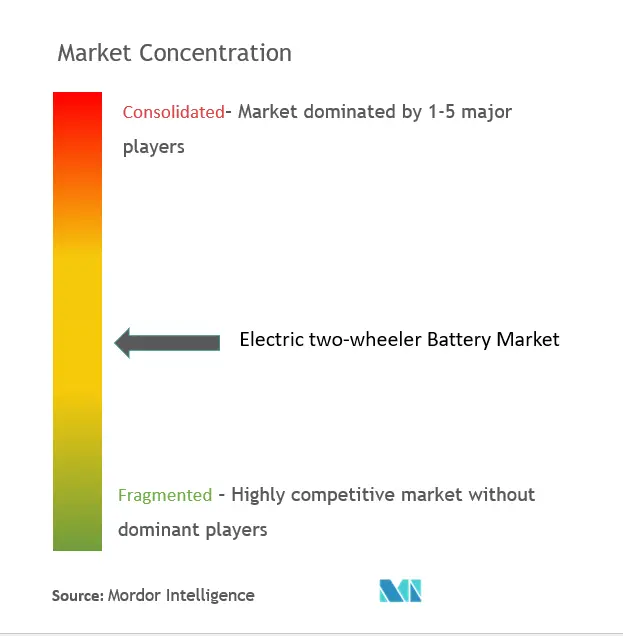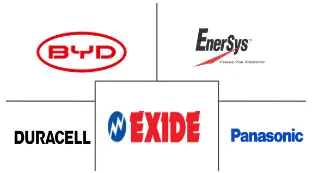Electric Two-wheeler Battery Market Size and Share

Electric Two-wheeler Battery Market Analysis by Mordor Intelligence
The Electric Two-wheeler Battery Market size is estimated at USD 12.11 billion in 2025, and is expected to reach USD 27.85 billion by 2030, at a CAGR of 18.13% during the forecast period (2025-2030).
- Over the medium term, rising adoption of electric vehicles (EV) and declining lithium-ion battery prices are expected to drive the demand for electric two-wheeler batteries during the forecast period.
- On the other hand, the supply chain constraints of raw materials can significantly restrain the growth of the electric two-wheeler battery market.
- Nevertheless, technological advancements in battery materials like higher energy density, faster charging times, improved safety, and longer lifespan are expected to create significant opportunities for the market players in the near future.
- Asia-Pacific is expected to be the fastest-growing region in the global electric two-wheeler battery market during the forecast period due to the rising adoption of two-wheeler electric vehicles.
Global Electric Two-wheeler Battery Market Trends and Insights
Lithium-ion Battery Type to Dominate the Market
- Lithium-ion (Li-ion) batteries are the predominant energy storage solution in the electric two-wheeler battery market due to their high energy density, long lifespan, and fast charging capabilities. These attributes make them ideal for use in electric motorcycles and scooters, which require lightweight and efficient power sources.
- The price of lithium-ion batteries is usually higher than that of other batteries. However, major players across the market have been investing to gain economies of scale and R&D activities to enhance their performance by increasing the competition and, in turn, resulting in declining prices of lithium-ion batteries.
- Owing to the increasing average battery pack prices of electric vehicles (EV) and battery energy storage systems (BESS), the battery prices declined in 2023 to USD 139 /kWh, a decrease of over 13%. The trajectory of technological innovation and manufacturing enhancements is anticipated to decrease the battery pack prices further, projecting the cost to reach USD 113/kWh in 2025 and USD 80/kWh in 2030.
- Furthermore, governments worldwide are significantly promoting electric vehicles due to rising environmental concerns. The government is significantly focused on net zero carbon emission targets. Lithium is a vital element in batteries that provides the storage capacity for EVs. The leading companies around the globe are raising funds to increase two-wheeler battery production and fulfill the rising demand for lithium-ion batteries.
- For instance, in October 2023, Ola Electric announced that it secured funding of INR 3,200 crore (USD 383.6 million) from Temasek-led investors and the State Bank of India. The investment is likely to be used to set up India’s first lithium-ion cell manufacturing facility in Tamil Nadu and expand Ola’s two-wheeler business.
- Additionally, governments worldwide have implemented various policies and incentives to promote two-wheeler electric vehicles. These policies have positively impacted the demand for lithium-ion batteries. The government announced numerous initiatives to promote EVs across the region.
- In Europe, various countries have implemented tax policies to promote the adoption of electric vehicles (EVs), including two-wheelers like electric motorcycles and scooters. For instance, since 2023, Germany has offered a range of subsidies for electric two-wheelers, including financial incentives for the purchase and installation of charging infrastructure. Similarly, Italy offers purchase incentives for electric two-wheelers and promotes the development of charging infrastructure through various tax benefits.
- Hence, such initiatives and projects are likely to accelerate the production and demand for two-wheeler EVs across the country in the coming years and raise the demand for lithium-ion batteries during the forecast period.

Asia-Pacific to Witness Significant Growth
- Asia-Pacific is a significant and rapidly growing market for electric two-wheeler batteries. This growth is driven by increasing demand for electric scooters, motorcycles, and bicycles due to various factors, including urbanization, environmental concerns, and supportive government policies.
- The demand for electric scooters, motorcycles, and bicycles is rising significantly across the region. For instance, according to Statista Market Insights data, in 2023, the sales of motorcycles were recorded at 45.85 million units, which increased by 2.8% compared to 2022. The group also estimated that the sales in 2029 are expected to be 51.63 million units. The data indicates an exponential increase in the sales of two-wheelers in the coming years, which may raise the demand for electric two-wheeler batteries during the forecast period.
- Many countries in Asia-Pacific have implemented policies and incentives to promote the adoption of electric vehicles, including two-wheelers. These include subsidies, tax incentives, and stringent emission norms that encourage the shift to electric mobility.
- For instance, since 2023, the Chinese government has provided substantial subsidies for the purchase of electric vehicles, including two-wheelers. These subsidies can cover a significant portion of the purchase cost. Similarly, the Indian government announced the Faster Adoption and Manufacturing of Hybrid and Electric Vehicles (FAME) scheme, which provides financial incentives for the purchase of electric two-wheelers. The government also reduced the GST on electric vehicles from 12% to 5%, making them more affordable. Such initiatives are likely to accelerate the production and demand for two-wheeler EVs across the country in the coming years and raise the demand for two-wheeler batteries during the forecast period.
- Furthermore, rapid urbanization and growing traffic congestion in major cities have led to an increased demand for efficient and eco-friendly transportation solutions, such as electric two-wheelers. The companies are significantly expanding their two-wheeler business worldwide and launching advanced two-wheelers across the regions.
- For instance, in October 2023, TVS Motor Company announced its collaboration with ION Mobility, a Singapore-based tech startup, to venture into the sports scooter segment in Indonesia. The entry into the market is to be made under "Project Dynamo," which is ION Mobility's conceptual adaptation of TVS Motor's premium flagship crossover electric two-wheeler, the TVS X. TVS Motor played a crucial role in ION Mobility's Series A funding, providing USD 18.7 million as a strategic investor. Such initiatives and funding are likely to raise the production of two-wheelers across the region and the demand for electric two-wheeler batteries during the forecast period.
- Such project developments showcase the feasibility and importance of two-wheeler battery solutions for battery energy storage systems in two-wheeler EVs. They are likely to raise the demand for electric two-wheeler batteries across the region in the coming years.

Competitive Landscape
The electric two-wheeler battery market is semi-fragmented. Some key players in the market (not in particular order) are BYD Company Ltd, Duracell Inc., Exide Industries Ltd, EnerSys, and Panasonic Holdings Corporation.
Electric Two-wheeler Battery Industry Leaders
-
Panasonic Holdings Corporation
-
EnerSys
-
Duracell Inc.
-
Exide Industries Ltd
-
BYD Company Ltd
- *Disclaimer: Major Players sorted in no particular order

Recent Industry Developments
- May 2024: Exide Industries Ltd collaborated with Hyundai and Kia and announced the supply of lithium-ion batteries for electric two-wheelers in India. The company is expected to set up a giga factory in Bengaluru to manufacture lithium-ion cells for two-wheelers and other EVs. The first phase of the facility, with a capacity of 6 GWh, is expected to be commissioned in 2025.
- April 2023: Globe Group’s 917Ventures, Ayala Corporation, and Gogoro Inc. collaborated and announced the launch of Gogoro Smartscooter® and battery-swapping equipped with advanced battery technology in the Philippines. The companies are introducing a new model of sustainable transportation that brings convenient and accessible electric two-wheelers to customers across the country.
Global Electric Two-wheeler Battery Market Report Scope
An electric two-wheeler battery is a rechargeable energy storage device that powers electric motorcycles and scooters. These batteries supply the necessary electrical energy to the vehicle’s motor, enabling it to operate without using fossil fuels. The key attributes of these batteries include high energy density, quick charging capabilities, and long cycle life.
The electric two-wheeler battery market is segmented by battery type, vehicle type, and geography. By battery type, the market is segmented into lithium-ion battery, lead-acid battery, and other battery types. By vehicle type, the market is segmented into electric motorcycle and electric scooter. The report also covers the market sizes and forecasts for the electric two-wheeler battery market across major regions. The report offers market sizes and forecasts in revenue (USD) for all the above segments.
| Lithium-ion Battery |
| Lead-Acid Battery |
| Other Battery Types |
| Electric Motorcycle |
| Electric Scooter |
| North America | United States |
| Canada | |
| Rest of North America | |
| Europe | Germany |
| France | |
| United Kingdom | |
| Italy | |
| Spain | |
| NORDIC | |
| Russia | |
| Turkey | |
| Rest of Europe | |
| Asia-Pacific | China |
| India | |
| Australia | |
| Japan | |
| South Korea | |
| Malaysia | |
| Thailand | |
| Indonesia | |
| Vietnam | |
| Rest of Asia-Pacific | |
| Middle East and Africa | Saudi Arabia |
| United Arab Emirates | |
| Nigeria | |
| Egypt | |
| Qatar | |
| South Africa | |
| Rest of Middle East and Africa | |
| South America | Brazil |
| Argentina | |
| Colombia | |
| Rest of South America |
| Battery Type | Lithium-ion Battery | |
| Lead-Acid Battery | ||
| Other Battery Types | ||
| Vehicle Type | Electric Motorcycle | |
| Electric Scooter | ||
| Geography [Market Size and Demand Forecast till 2029 (For Regions Only)] | North America | United States |
| Canada | ||
| Rest of North America | ||
| Europe | Germany | |
| France | ||
| United Kingdom | ||
| Italy | ||
| Spain | ||
| NORDIC | ||
| Russia | ||
| Turkey | ||
| Rest of Europe | ||
| Asia-Pacific | China | |
| India | ||
| Australia | ||
| Japan | ||
| South Korea | ||
| Malaysia | ||
| Thailand | ||
| Indonesia | ||
| Vietnam | ||
| Rest of Asia-Pacific | ||
| Middle East and Africa | Saudi Arabia | |
| United Arab Emirates | ||
| Nigeria | ||
| Egypt | ||
| Qatar | ||
| South Africa | ||
| Rest of Middle East and Africa | ||
| South America | Brazil | |
| Argentina | ||
| Colombia | ||
| Rest of South America | ||
Key Questions Answered in the Report
How big is the Electric Two-wheeler Battery Market?
The Electric Two-wheeler Battery Market size is expected to reach USD 12.11 billion in 2025 and grow at a CAGR of 18.13% to reach USD 27.85 billion by 2030.
What is the current Electric Two-wheeler Battery Market size?
In 2025, the Electric Two-wheeler Battery Market size is expected to reach USD 12.11 billion.
Who are the key players in Electric Two-wheeler Battery Market?
Panasonic Holdings Corporation, EnerSys, Duracell Inc., Exide Industries Ltd and BYD Company Ltd are the major companies operating in the Electric Two-wheeler Battery Market.
Which is the fastest growing region in Electric Two-wheeler Battery Market?
Asia Pacific is estimated to grow at the highest CAGR over the forecast period (2025-2030).
Which region has the biggest share in Electric Two-wheeler Battery Market?
In 2025, the Asia Pacific accounts for the largest market share in Electric Two-wheeler Battery Market.
What years does this Electric Two-wheeler Battery Market cover, and what was the market size in 2024?
In 2024, the Electric Two-wheeler Battery Market size was estimated at USD 9.91 billion. The report covers the Electric Two-wheeler Battery Market historical market size for years: 2019, 2020, 2021, 2022, 2023 and 2024. The report also forecasts the Electric Two-wheeler Battery Market size for years: 2025, 2026, 2027, 2028, 2029 and 2030.
Page last updated on:
Electric Two-wheeler Battery Market Report
Statistics for the 2025 Electric Two-wheeler Battery market share, size and revenue growth rate, created by Mordor Intelligence™ Industry Reports. Electric Two-wheeler Battery analysis includes a market forecast outlook for 2025 to 2030 and historical overview. Get a sample of this industry analysis as a free report PDF download.



